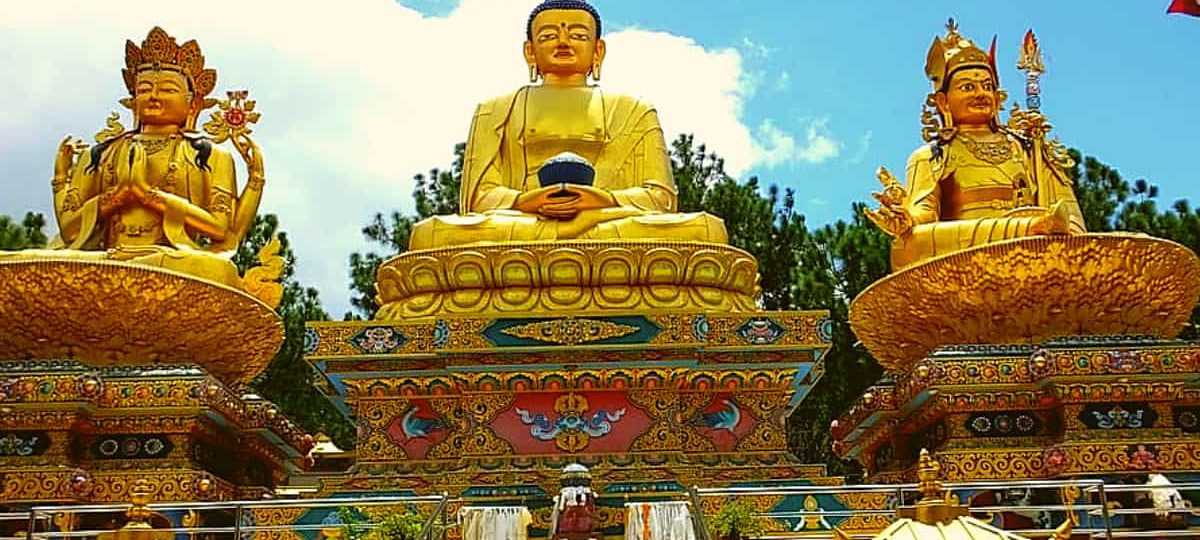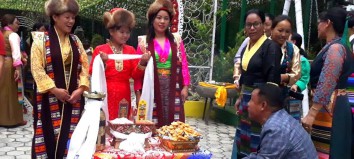The Three Roots Buddhism

The three roots (Tibetan: Tsa sum) of the Tibetan Buddhist tradition are the Lama (Sanskrit: Guru), Yidam (Sanskrit: Ishadevata), and Khandroma ( Sanskrit: dakini) or Chokyong (Sanskrit: dharmapala). The three roots are the second of three Tibetan Buddhist refuge formulation, the Outer, Inner and Secret sorts of the Three Jewels. The outer form known as “Triple Gem” (Triratna), the inner known as Three roots and also the Secret form called Three Bodies or trikaya of a Buddha.
- The Lama is the ‘root of blessing’ or the ‘root of grace’
- The Yidam is the ‘root of method’ or ‘root of accomplishment’
- The Khandroma or Chokyong is the ‘root of protection’ or ‘root of activity’.
LAMA
The Tibetan word “Lama” means “Guru” in Sanskrit, and the literal meaning of it is “difficult”. This is not meant in the physical sense, but in such a way that the guru is “heavy” in that he has many qualities. The guru embodies qualities that he previously realized himself. That is why he is someone on whom the student can rely and whom he can trust.

These qualities are not just about the amount of teaching the guru knows, but above all about knowing exactly what will benefit the student. The guru is able to appropriately teach, inspire and guide the student on the way. He does not teach something that confuses the student and gives him even more thoughts and ideas. He can give the student clarity and trust so that his path quickly bears fruit.
The Tibetan word for the teacher is “Lama”. The literal meaning of “La” is something higher that you look up to. This also relates to the quality of the teacher, namely that he is someone the student can trust.
The meaning of the teacher is seen somewhat differently in the various Buddhist vehicles. On the one hand there is the Theravada, the small vehicle, and on the other hand there is the Mahayana, the large vehicle. But the general meaning in both vehicles is that the teacher is a spiritual friend. Chandrakirti, who was one of the greatest Buddhist teachers, explains that the Lama should have the quality to meet the needs of the student. Whatever he has to learn along the way, the lama can give him that.
In addition to this general quality of a Buddhist teacher, there are some special qualities in the Mahayana that should distinguish a teacher.
The teacher should have a peaceful nature, a calm mind. It shouldn’t be rough or aggressive.
He should know more and have more qualities than the student. He should not only know a lot, but also have love and compassion and teach out of compassion.
The teacher should not tire of his work, this can be very exhausting if he is busy with the students and guides them all the time. The teacher should be willing and able to do it.
The teacher should have experience in meditation and realization. In the Mahayana there is the sutra and the tantra. For a teacher of the tantra, the diamond path, there are even more qualities that are necessary.
A teacher of tantric remedies must be skilled in these methods. The benefit that a student can have from empowerment is that his mind matures. This means that the teacher should be someone who is capable of giving empowerment and teaching tantric methods, must be adept at these methods and rituals. He has to know the mandalas, the mantras, all the mudras, etc. the whole thing is a science in itself.
The teacher must have experience with methods of this path. Then it is actually possible for the student to get the results of practice in this life. Being a diamond way teacher is a big responsibility. The methods of the Vajrayana are very powerful and the results come very quickly. Therefore, the teacher has to be very careful, because if he does something wrong, the results can be quite dramatic.
All of these qualities and definitions of a teacher are difficult to fulfill nowadays, that everything is rather something from earlier times. The very profound methods of the diamond path can no longer be practiced so easily today because it is difficult to find the right type of teacher and student. This is not the fault of the teacher or the student, but simply has to do with the times in which we currently live.
You may say to each other now; Okay, then I better forget it. But that’s not how you should think. It is difficult to find all these qualities nowadays, but it is still good for us to do the practice. In both ways within the Mahayana it is really important and then sufficient if the student has very strong and stable trust and devotion and his mind does not change. The teacher should be able to guide the student in a great manner and not make any mistakes. He must also be completely motivated by love and compassionate wine. if these conditions come together, the practice will be good. This does not mean, however, that the student is required to have blind faith. He must already know exactly what he is doing. He must learn and understand the dharma and then put his faith in the teachings. The teacher should know what he is teaching. It must be based on knowledge, experience and practice and be error-free. it is very important that the connection between teacher and student remains intact. there should be no broken volumes between them, which is actually the most important thing. for this it is important that the teacher’s speech is pure, that the student’s mind is pure and that the dharma is pure. nowadays it is not so easy to find a pure, correct speech. It is also not easy to find a mind without disturbances and 100% correct instructions. So here we come back to the point of how important trust on the part of the pupil and compassion on the part of the connection in order and the band is held.
To give an example: if someone wants to prepare good food, many conditions have to come together so that something tasty comes out of it. But if the right ingredients are there, even someone who is not an expert can make a decent meal that is good to eat and that may also be tasty.
Yidam
What we call “yidam” in Tibetan is often translated as “deity”. There are secular and non-secular deities, and in all cultures there are five categories of beings you look up to.

The first is someone in a high position in a country, for example a king or minister. Everyone respects such a person and regards them as an authority. There are many countries where kings are almost worshiped like gods. Then there are also gods of nature. In some countries people believe that the trees are gods or that the water is a god etc. There are many places in the world where people worship these types of gods.
There are gods as a form of existence in the conditioned world. one can be reborn as a god, in one of the different paradises in the gods.
There is a fifth kind of God that is perfectly pure. This concerns the Buddhas, the enlightened beings, also the different Buddha aspects such as loving eyes, Manjushri etc. just the Yidams.
I don’t want to criticize other religions here, but in fact all the different Hindu gods like Ishvara, Vishnu etc. also the Christian God or Allah are not considered to be completely pure. they belong to the category of worldly gods. when we speak of “lama, yadam, dakini and protectors” about deities, then we see the yidams as completely traps of the worldly gods, this is not the case, because they have inner problems, fight with each other etc. However, the perfectly perfect deities are completely beyond it. They have no faults, no mistakes and all qualities have fully matured.
A yidam is a Buddha aspect that can bring the student to full enlightenment. The student’s goal is to achieve this state of perfection, and through the Buddha aspect, he can achieve the goal. The word yidam (sanskrit-Ishta Deva) actually describes this process. “Yi” means spirit and refers to the student’s state of mind, namely that he has the desire to endure enlightenment. “Dam” is a kind of promise for this and the Buddha aspect helps him to enlighten. So there is a kind of obligation between the student and the Buddha aspect, which enables enlightenment.
Let’s take the example that the yidam is Dorje chang. the student then wishes to attain the state of dorje chang. This state of mind of the student is the “yi”. The “Dam” is the promise that the student gives to achieve the state of Dorje Chang. The object of his mind is dorje chang he promises to attain its level.
There are many different yidams in the different tantra kriya, charya, yoga, and anuttara yoga tantra, but they are all yidams in the sense just explained, and all are equally good to practice. there are male and female yidams, but at the level of truth (Dharmakaya) one cannot speak of male and female in the way we normally do. It has a different meaning here. In terms of their quality, all yidams are the same regardless of whether they are male or female or what type of yidams they belong to. The choice of yidam depends on the student. Some yidams will feel particularly drawn, for example some prefer to meditate on female Buddhas like dorje phagmo, Drolma etc., others prefer male Buddhas like kalachakra, Manjushri or Dorje chang. there is no difference at all regarding the quality of the yidams. the students choose a yidam that suits them, and the realization is always the same for all yidams.
The important thing when practicing a yidam is to choose the right yidam. this is not something that happens casually, such as that you like one yidam today and tomorrow nothing more and choose another. this is not possible, because if you practice the yidams like this, you will not get the results. The selection of the yidam is something very conscious and you do it together with the teacher. There are different ways to find out which yidam is suitable for one person. if it is done in the right way, the results will come.
It is also important to know that the yidam is not just the form of the Buddha. In fact it contains everything possible, such as the mantra and the germ syllable, you cannot separate them from each other. The mantra itself can be the yidam, as can the seed syllable. Every yidam has a mantra that corresponds to it and a germ syllable that corresponds to it, which belong together. if that does not come together, there is no realization. we should not see the yidam as something external, which gives us the realization from the outside. The yidam is rather something that we have to bring to life in our minds.
Khandro (Dakini and protectors)
The lama shows us the way and the yidam is the real way, what we practice and realize. The Dakas, Dakinis and Protectors are the ones who help us on the way. For example, if our yidam is dorje chang, then the teacher gives us the instructions and we then meditate on dorje chang. The Dakas and Dakinis help us to realize dorje chang, to get the meditation results.

The Dakas are male, the Dakinis female, and there are white varieties here, namely secular and non-secular Dakas and Dakinis. The secular are generally male and female demons. They don’t have to look terrifying, but they are harmful and disruptive energies. They are worldly in the sense that they can get angry and then harm you. Up to a point they can help you, but not completely, they cannot lead us beyond the worldly. If you are dissatisfied, you can turn against yourself.
The non-worldly Dakas and Dakinis are the ones that help us to a level of liberation and enlightenment. Above all, the Dakas help remove external obstacles. The main activity of the Dakinis is to develop the inner realization. These are the respective priorities in the activity of the Dakas and Dakinis, but in general both remove both external and internal obstacles. What does it mean that the Dakinis develop inner realization? In the Diamond Way practice, the process of converting disturbances is realized. The essence of disturbance is wisdom, and you get it by recognizing the nature of the disturbing emotion. This realization goes hand in hand with the feeling of joy.
The help that you get here through the activity of the Dakinis is in particular that the joyful knowledge of the nature of wisdom is strengthened. The Dakinis help in the way that they enable the practitioner to achieve the state of joy through sensory objects that are inherent in the knowledge of wisdom.
For this reason, in the Tantra practice it is always the Dakinis who bring gifts as goddesses. they bring all the different types of sensory objects that we give in practice. you will never see Dakas in this function here, they are always Dakinis. By perceiving the different objects through seeing, smelling, tasting, feeling and hearing, the Dakinis give us the different types of senses. This is your method of helping us to be released. Similarly, there are categories of male and female protectors. It is also the case here that the male protectors above all remove external obstacles and the female protectors help us with the various types of realization. Dakas and Ddakinis as well as male and female protectors are like friends on the way to liberation. Regardless of whether a practitioner follows the sutra or the tantra, he must generally understand what his current situation is and what he actually wants to achieve. we have to recognize the shortcomings in our ordinary existence and the qualities of the enlightened state, and then practice the path that leads us to that perfect state. Buddha’s teachings will definitely take us there.
It is important that we understand correctly that there are mistakes in our normal existence. this is not about something external, but that the root of our problems lies in our troubled feelings and you have to do something about them. this is the cause of all problems and that’s why we have to concentrate on it. It is not Buddhist to always say that he or she is bad, so always project outside and judge other people. This is definitely not the way to change anything, because our problems are always caused by disturbances. This is the basic Buddhist mindset.









